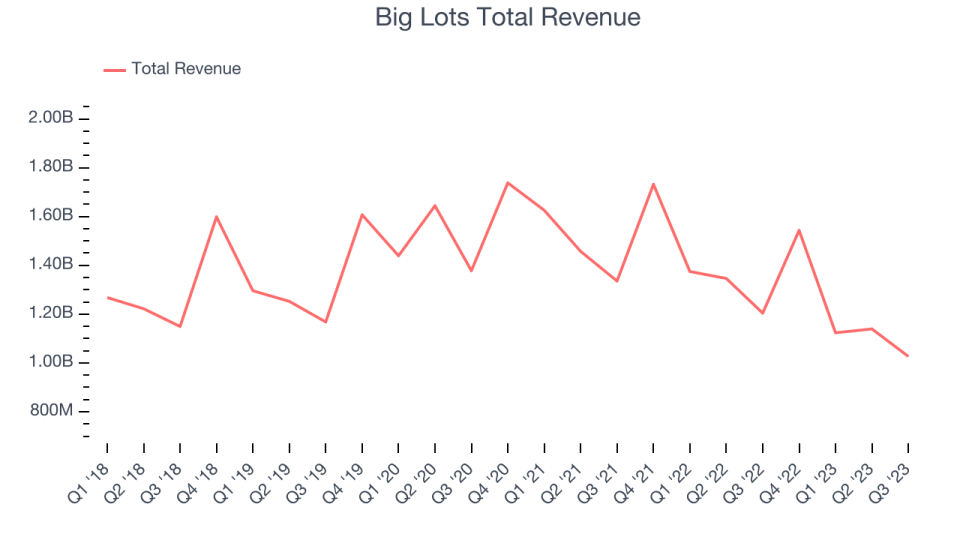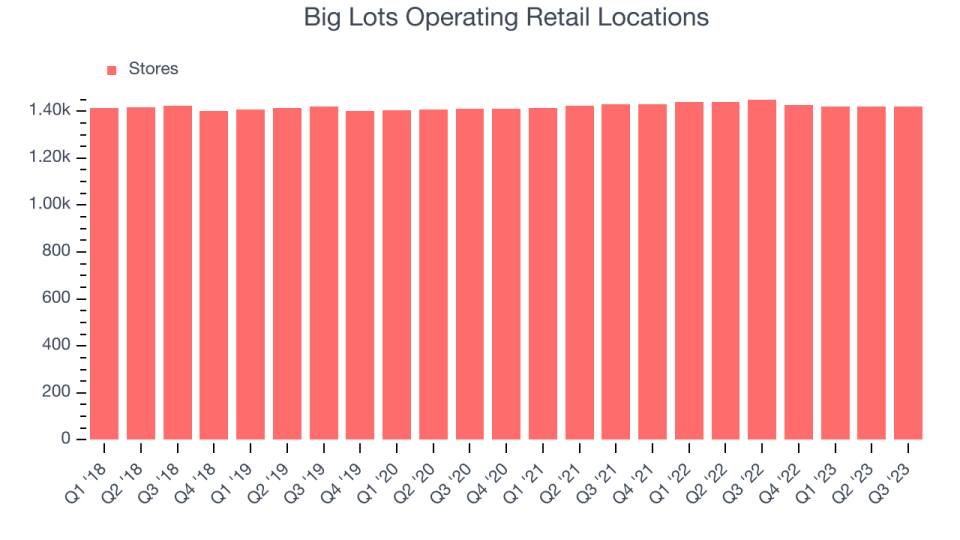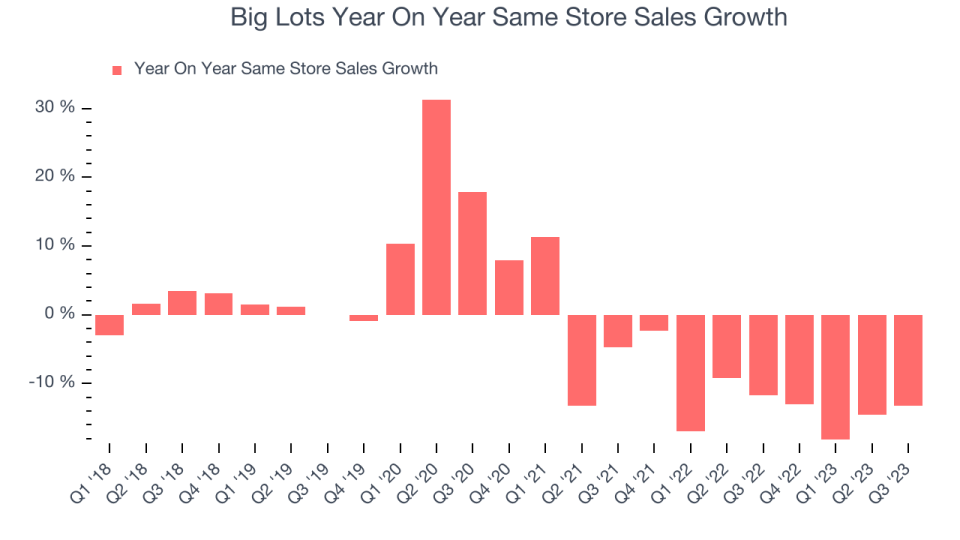Big Lots (NYSE:BIG) Misses Q3 Revenue Estimates, But Stock Soars 5.6%

Discount retail company Big Lots (NYSE:BIG) reported results in line with analysts' expectations in Q3 FY2023, with revenue down 14.7% year on year to $1.03 billion. It made a GAAP profit of $0.16 per share, improving from its loss of $3.56 per share in the same quarter last year.
Is now the time to buy Big Lots? Find out by accessing our full research report, it's free.
Big Lots (BIG) Q3 FY2023 Highlights:
Revenue: $1.03 billion vs analyst estimates of $1.03 billion (small miss)
EPS (non-GAAP): -$4.38 vs analyst estimates of -$4.67 ($0.19 beat)
Positive commentary on Q4 and 2024
Gross Margin (GAAP): 36.4%, up from 34% in the same quarter last year (beat)
Same-Store Sales were down 13.2% year on year (in line)
Store Locations: 1,420 at quarter end, decreasing by 30 over the last 12 months
Commenting on today's results announcement, Bruce Thorn, President and CEO of Big Lots stated, "Although the environment remains challenging, we continued to make significant progress in turning around our business. Our key strategic actions are building momentum and we continue to play offense with our efforts to deliver incredible bargains and communicate unmistakable value. As a result, we are now on track to deliver an adjusted Q4 operating result ahead of last year, which would mark the first quarter of year-over-year improvement in nearly three years, and we expect quarterly year-over-year improvements to continue through 2024."
Priding itself on carrying brand-name items, Big Lots (NYSE:BIG) is a discount retailer that acquires excess and overstocked inventory then sells at meaningful discounts to prices of traditional retailers
Discount General Merchandise Retailer
Broadline discount retailers understand that many shoppers love a good deal, and they focus on providing excellent value to shoppers by selling general merchandise at major discounts. They can do this because of unique purchasing, procurement, and pricing strategies that involve scouring the market for trendy goods or buying excess inventory from manufacturers and other retailers. They then turn around and sell these snacks, paper towels, toys, and myriad other products at highly enticing prices. Despite the unique draw and lure of discounts, these discount retailers must also contend with the secular headwinds of online shopping and challenged retail foot traffic in places like suburban strip malls.
Sales Growth
Big Lots is a mid-sized retailer, which sometimes brings disadvantages compared to larger competitors benefiting from better economies of scale. On the other hand, it has an edge over smaller competitors with fewer resources and can still flex high growth rates because it's growing off a smaller base than its larger counterparts.
As you can see below, the company's revenue has declined over the last four years, dropping 2.3% annually as it failed to grow its store footprint meaningfully and observed lower sales at existing, established stores.

This quarter, Big Lots reported a rather uninspiring 14.7% year-on-year revenue decline, missing Wall Street's expectations. Looking ahead, analysts expect revenue to decline 4.7% over the next 12 months.
The pandemic fundamentally changed several consumer habits. There is a founder-led company that is massively benefiting from this shift. The business has grown astonishingly fast, with 40%+ free cash flow margins. Its fundamentals are undoubtedly best-in-class. Still, the total addressable market is so big that the company has room to grow many times in size. You can find it on our platform for free.
Number of Stores
A retailer's store count often determines on how much revenue it can generate.
When a retailer like Big Lots keeps its store footprint steady, it usually means that demand is stable and it's focused on improving operational efficiency to increase profitability. Big Lots's store count shrank by 30 locations, or 2.1%, over the last 12 months to 1,420 total retail locations in the most recently reported quarter.

Taking a step back, the company has kept its physical footprint more or less flat over the last two years while other consumer retail businesses have opted for growth. A flat store base means that revenue growth must come from increased e-commerce sales or higher foot traffic and sales per customer at existing stores.
Same-Store Sales
Big Lots's demand has been shrinking over the last eight quarters, and on average, its same-store sales have declined by 12.4% year on year. This performance is quite concerning and the company should reconsider its strategy before investing its precious capital into new store buildouts.

In the latest quarter, Big Lots's same-store sales fell 13.2% year on year. This decrease was a further deceleration from the 11.7% year-on-year decline it posted 12 months ago. We hope the business can get back on track.
Key Takeaways from Big Lots's Q3 Results
With a market capitalization of $140.1 million, Big Lots is among smaller companies, but its more than $46.59 million in cash on hand and near break-even free cash flow margins puts it in a stable financial position.
We were impressed by how significantly Big Lots blew past analysts' EPS expectations this quarter. We were also glad its gross margin outperformed Wall Street's estimates. On the other hand, its revenue unfortunately missed analysts' expectations. Overall, we think this was a strong quarter that should satisfy shareholders. The stock is up 4.2% after reporting and currently trades at $5 per share.
So should you invest in Big Lots right now? When making that decision, it's important to consider its valuation, business qualities, as well as what has happened in the latest quarter. We cover that in our actionable full research report which you can read here, it's free.
One way to find opportunities in the market is to watch for generational shifts in the economy. Almost every company is slowly finding itself becoming a technology company and facing cybersecurity risks and as a result, the demand for cloud-native cybersecurity is skyrocketing. This company is leading a massive technological shift in the industry and with revenue growth of 50% year on year and best-in-class SaaS metrics it should definitely be on your radar.
Join Paid Stock Investor Research
Help us make StockStory more helpful to investors like yourself. Join our paid user research session and receive a $50 Amazon gift card for your opinions. Sign up here.
